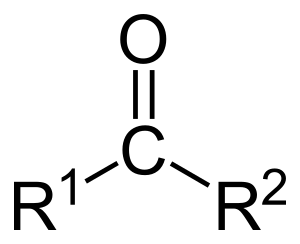Ketone facts for kids
A ketone is a special type of organic compound. Organic compounds are chemicals that contain carbon atoms. In a ketone, there's a carbon atom that is strongly connected to an oxygen atom with a "double bond." This special part is called a carbonyl group. This same carbon atom is also connected to two other carbon atoms.
Ketones are found all around us and even inside our bodies! They are important in many areas, from how our bodies work to making useful products.
Contents
What are Ketones?
Ketones are part of a big family of chemicals. They have a unique structure that makes them useful for different things. Think of them as building blocks in the world of chemistry.
How Ketones are Made
Ketones can be made through chemical reactions. For example, they can be formed when certain types of alcohols (called secondary alcohols) undergo a process called oxidation. This is like a chemical change that adds oxygen or removes hydrogen.
Where We Find Ketones
Ketones are in many places:
- In our bodies: When your body uses fat for energy instead of sugar, it produces ketones. This happens during fasting or when following certain diets.
- In everyday products: Some ketones are used as solvents, which means they can dissolve other substances. A common example is acetone, which is found in nail polish remover.
- In nature: Ketones can be found in natural scents and flavors. For example, muscone is a ketone that gives musk its unique smell.
Examples of Ketones
There are many different kinds of ketones, each with its own special uses.
- Acetone: This is one of the simplest and most well-known ketones. It's a clear liquid often used as a solvent.
- Cyclohexanone: This ketone is important for making nylon, a strong material used in clothes and many other products.
- Tetracycline: This is a type of antibiotic, which is a medicine that helps fight bacterial infections.
Images for kids
-
Different types of ketones. From left to right: acetone (a common solvent), oxaloacetate (important in how our bodies use sugar), acetylacetone, cyclohexanone (used to make nylon), muscone (an animal scent), and tetracycline (an antibiotic).
See also
 In Spanish: Cetona (química) para niños
In Spanish: Cetona (química) para niños


